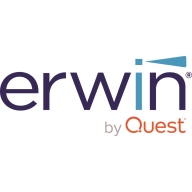

Find out what your peers are saying about Microsoft, Informatica, Talend and others in Data Integration.


Azure Data Factory efficiently manages and integrates data from various sources, enabling seamless movement and transformation across platforms. Its valuable features include seamless integration with Azure services, handling large data volumes, flexible transformation, user-friendly interface, extensive connectors, and scalability. Users have experienced improved team performance, workflow simplification, enhanced collaboration, streamlined processes, and boosted productivity.
erwin Data Catalog (DC), part of the erwin Data Intelligence Suite, automates enterprise metadata management, including data mapping, code generation, data profiling, data lineage and impact analysis. It integrates and activates data in a single, unified catalog in accordance with business requirements by scheduling ongoing scans of metadata from the widest array of data sources, keeping metadata current with full versioning and change management, and easily mapping data elements from source to target, including data at rest and in motion, and harmonize data integration across platforms.
We monitor all Data Integration reviews to prevent fraudulent reviews and keep review quality high. We do not post reviews by company employees or direct competitors. We validate each review for authenticity via cross-reference with LinkedIn, and personal follow-up with the reviewer when necessary.